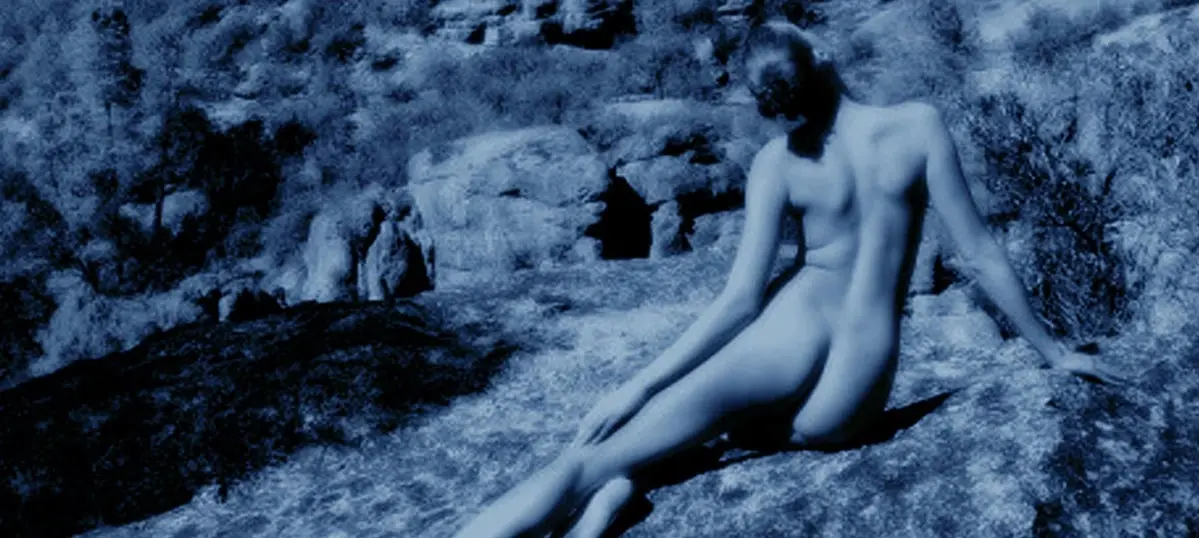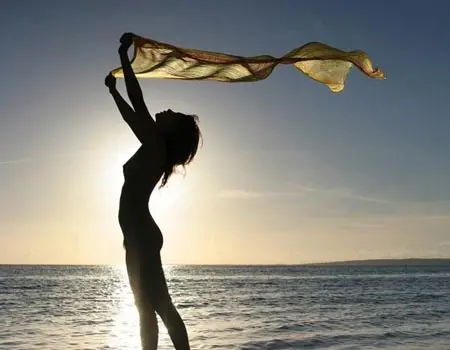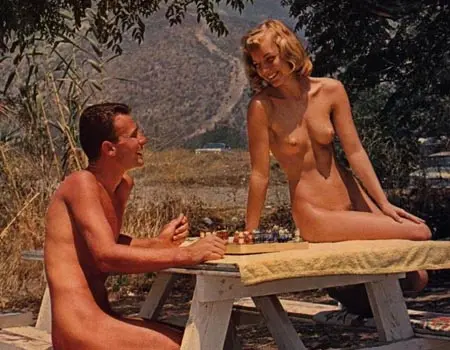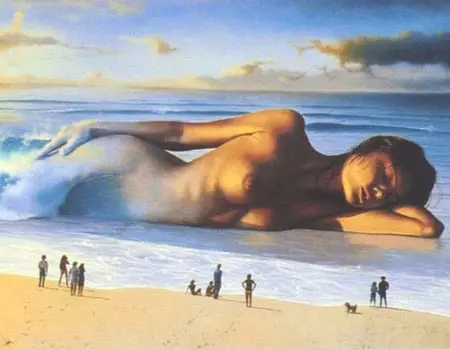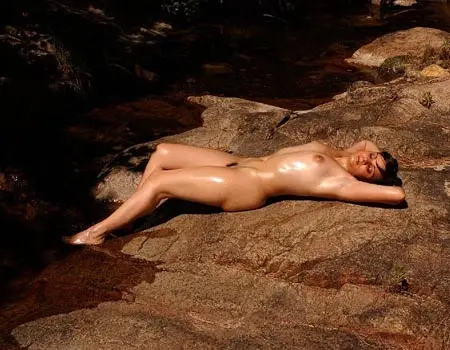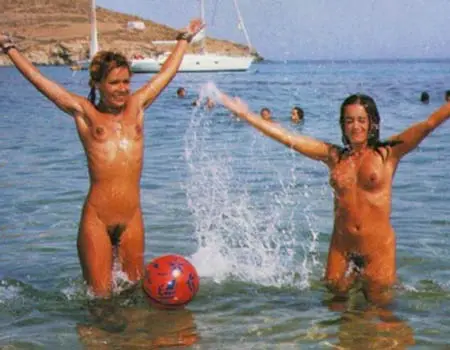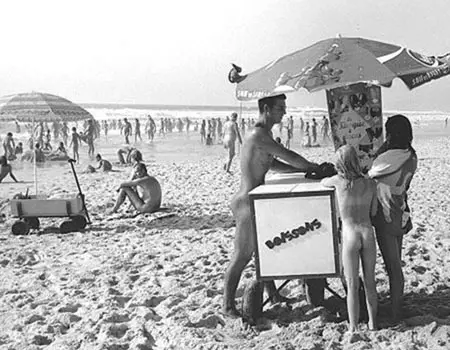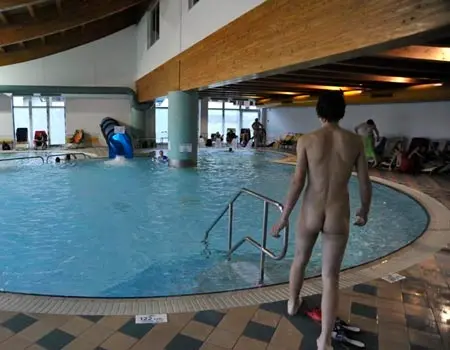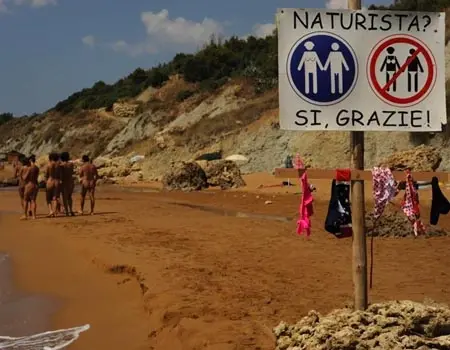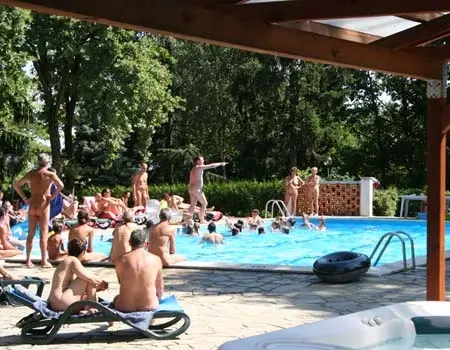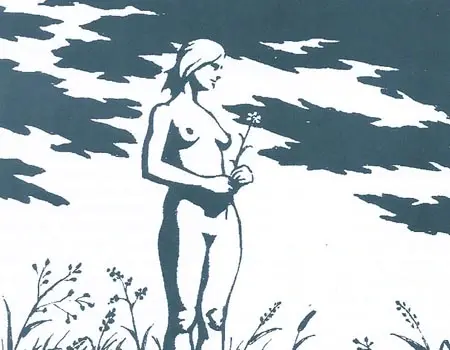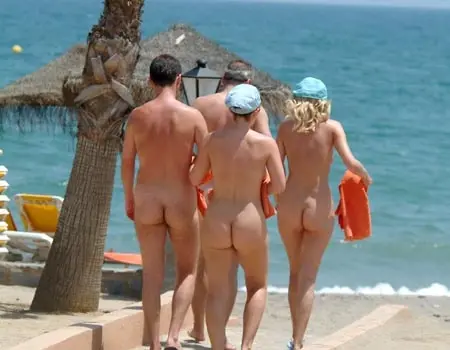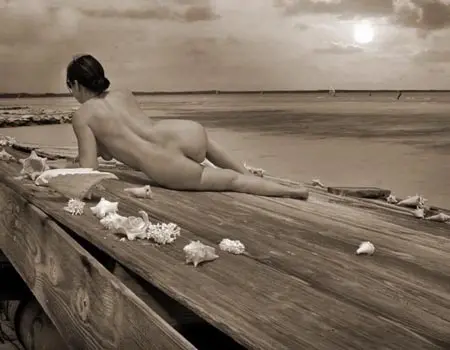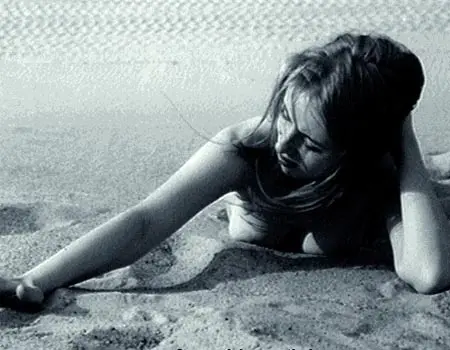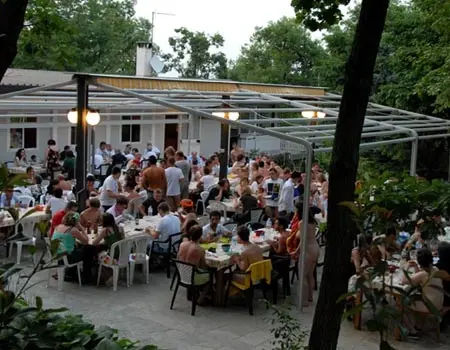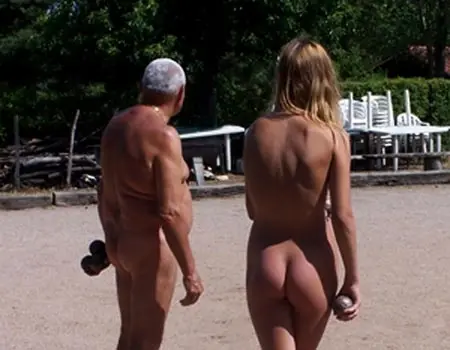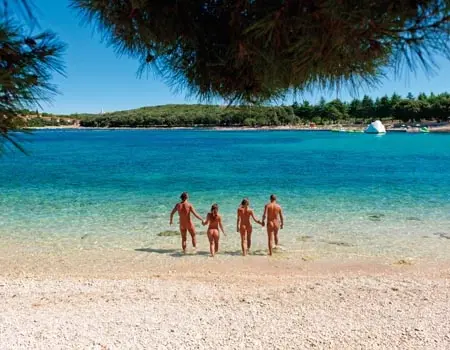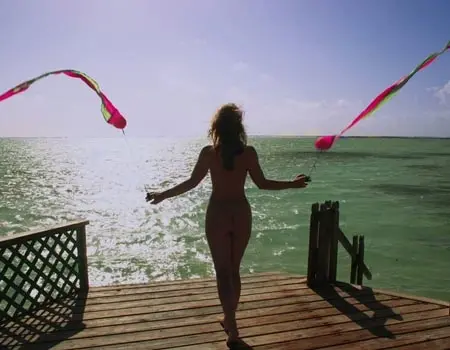Out of the closet
Naked City claims 50,000 day visitors on its mailing list, double the membership of the entire American Sunbathing Association.
It is a near-pomographic Disneyland, one of many independent commercial resorts in America to cash in on the permissiveness and raise two fingers to the restraining influence of the A.S.A.
The American Sunbathing Association may huff and puff, but it has plenty on its plate holding in check those of its own clubs which are exploiting the equals sign between nudity and dollars. One of the most flamboyant, the Treehouse Fun Ranch nearSan Bernadino in Califomia, has recently clashed swords with the A.S.A.
It is a near-pomographic Disneyland, one of many independent commercial resorts in America to cash in on the permissiveness and raise two fingers to the restraining influence of the A.S.A.
The American Sunbathing Association may huff and puff, but it has plenty on its plate holding in check those of its own clubs which are exploiting the equals sign between nudity and dollars. One of the most flamboyant, the Treehouse Fun Ranch nearSan Bernadino in Califomia, has recently clashed swords with the A.S.A.
It packs in the sightseers with the most American of all crowd-pullers, the Beauty Pageant. It is a world gone mad. The day begins with the Buff Divers, naked skydivers, parachuting into the swimming pool.
Because of the harnesses and helmets, almost the only parts of the body on display are the very ones which more modest souls would wish to hide. Next comes the oath of allegiance to the American flag: three thousand naked people, chanting in unison, like a bizarre parody of some ancient rite.
Then the hapless giri contestants parade themselves to gawping public scrutiny and clicking cameras in front of a tatty scenic backdrop which obscures the natural beauty beyond.
The 'free beach' campaign, started a quarter of a century ago, has never enjoyed enthusiastic support and outside the nudist parks and the cinema, nakedness remains taboo. In 1981 the American Sunbathing Association celebrated its Golden Jubilee. In the middle of a new bout of in-fighting, delegates could not help wondering whether the breakt hrough would ever come. One of the trustees did his best to rally the doubting Toms.
Imagining himself to be the Martin LutherKing ofthe nudists, Hap Hathaway told o fhis dream: I see in our future. . . nudist cities offering all of the services customarily found in a.modern metropolis. Not only will they contain all ofthe aspects of modern living, but they will also be climatically controlled. . . They will have gleaming towers, sunlit expanses, and delightful thoroughfares.
And everywhere you look you will see rustic benches, shade trees and fountains. Everyone will admire these cities as being finer and more beautiful than anything they have imagined. Of course the real beauty is that these cities will be designed by, and built for, nudists.
A pipe dream? Well, five years ago, very definitely a pipe dream. To-day, maybe. But five years from to-day this type of nudist city could very well be on the drawing boards ofthe top macroengineers in the count.
It seems more likely that Hap Hathaway's pipe dream will first become a reality in Europe where it all began. Cap d'Agde in the South ofFrance must be numbered among the wonders of the world. Like the originaI seven, it is unique and no words can adequately describe it. It has to be experienced in the flesh.
Picture a beach, a mile long, where you can hardly see the sand for naked bodies. Imagine thousands windsurfing, sailing, waterskiing, swimming, paddling, flying kites, building sand castles - all in the nude.
Think of a towl?- with a population the size of Stratfordon-Avon (approx. 20,000) and visualize, ifyou can, everyone except the shopkeepers, stark naked.
That gives an idea of what the Zone Naturisteat Cap d'Agde is like. It all began forty years ago. René and Paul Oltra are the sons of a peasant far1i1er who scratched a living from his vineyard on the Languedoc coast, seventy miles from the Spanish border.
The vines ran down to the Mediterranean where they struggled to bear fruit in a losing battle with the sand and salto In 1940 France fell to the Germans. It was not long before the soldiers of the victorious arniydiscovered the beach which bordered the Oltras' vineyard. To theastonishment of the two boys, René and Paul, they chose to swim naked. Even more astonishing, the German soldiers liked to do their physical jerks naked too. Paùl remembers talking to them.
They were thrilled with their discovery of a perfect and deserted beach. 'When we have won the war, we will come back here with all our friends; they told him. Due to circumstances beyond their control it was ten years before they started coming back. René and Paul welcomed them. In the poverty of post-war France, a month's rental on a camp site was worth far more than the grapes which that land could produce.
By 1965, word had spread and budget-conscious holidaymakers from all over Europe were flocking to the Oltras' camp site to bask naked in the Mediterranean sunshine.
The Oltras pulled up their vines, built some utility holiday bungatows and thanked their lucky stars. In that same year, the French government embarked on an extraordinarily ambitious scheme to develop the Languedoc coast.
Traditionally, holiday niakers had always turned left at the bottom of the Rhone valley and headed east along the Riviera to St. Tropez, Cannes, Nice and Monte Carlo. From the Camargue, west of Marseille, the coast was practically deserted all the way to Perpignan on the Spanish frontier. The beaches were far better than on the Riviera but the mosquitoes made existence hell. First the government eradicated the mosquitoes.
Then it started construction of the motorway from Orange to Spain, bringing access to the new holiday resorts it was building at Port Camargue, La Grande Motte, Carnon, Cap d'Agde, Gruissan, Port Leucate, Port Bacares and Saint Cyprien. To-day the Languedoc coast is one of the most popular on the Mediterranean, a success story and money-spinner. One of the many obstacles which stood in the planners' way was the altras' nudist campo.
The easy way out would have been to obliterate it: the planners had draconian powers. Instead they decide& to capitalise on it and designate twenty acres adjoining the camp a zone naturiste. It was a brave decision, tactfully handled.
The people of the Languedoc do not readily accept the decisions handed down to them by the panjandrums of Paris, five hundred miles away. But they were persuaded that nudists meant more tourists and they knew that tourists meant money. The plan went ahead.
The zone naturiste was to be the world's first nudist town, designed to house 20,000 holidaymakers in appartments and villas. The altra camp site was to stay and the land for the new town, provided with water, electricity and drainage, was put up for sale, to anyone adventurous enough to take the risk.
The Oltra brothers realised at once that they were sitting ona fortune, next door to a gold mine. They'had little money to invest but the banks knew the potential and readily gave credito. The Oltras started construction. Port Ambonne was completed first in 1971. It is a circular complex of 150 flats, with shops, restaurants, bars, a petrol station, a swimming pool and a night club.
Adjoining the flats the government has built a marina for the nudists' yachts. Next, the Oltras built Héliopolis, named after France's first nudist resort on the Ile du Levant, a concrete horseshoe of 900 flats, facing the sea. Meanwhile, to break the Oltra monopoly, the government gave construction of the third great complex, Port Nature, to another developer. Now there are 2,000 apartments at Cap d' Agde's zone naturiste, 800 villas, 50 shops, 20 restaurants, 4 bars, 4 swimming pools, 3 banks, 3 hairdressers, 2 night clubs and an open-air cinema.
The camp site has been enlarged to accommodate 12,000 people, many on permanently rented sites. During the summer weekends, when vast numbers of day visitors, both locaI and foreign, join the throng, there are as many as ten thousand people jammed on to little more than a mile of beach. It sounds quite awful.
The odd tbing is, it is quite the reverse: so many people seem to enjoy themselves without a hint of aggression.
The children, especiaIly, seem to find it heaven on earth. The occasional curious textile, it is true, is greeted witb ribald shouts of à poiland 'get-'em-orf, but always more in fun tban anger. When the nudist beach was first established at Cap d'Agde, a high fence was erected to shield the textiles from the shameful sights and the nudists from the peeping Toms.
No one now can tell you where that fence should be: even the most incorrigible of Toms need peep no more. The phenomenal growth of nudity on the beaches of Europe could not have happened had the textiles not liked the look of it and decided, in their thousands, to give it a try.
The men are surprised that they do not embarrass themselves; the women amazed that others have breasts and bottoms, too big and too small: the ad man's image of the perfect woman, they discover, is a wicked lie. These lapsed textiles tell you that to swim and play naked is a blessed relief, an exhilarating liberation. Are they mad, or is to be naked on a sunny beach really as Nature intended?
Because of the harnesses and helmets, almost the only parts of the body on display are the very ones which more modest souls would wish to hide. Next comes the oath of allegiance to the American flag: three thousand naked people, chanting in unison, like a bizarre parody of some ancient rite.
Then the hapless giri contestants parade themselves to gawping public scrutiny and clicking cameras in front of a tatty scenic backdrop which obscures the natural beauty beyond.
The 'free beach' campaign, started a quarter of a century ago, has never enjoyed enthusiastic support and outside the nudist parks and the cinema, nakedness remains taboo. In 1981 the American Sunbathing Association celebrated its Golden Jubilee. In the middle of a new bout of in-fighting, delegates could not help wondering whether the breakt hrough would ever come. One of the trustees did his best to rally the doubting Toms.
Imagining himself to be the Martin LutherKing ofthe nudists, Hap Hathaway told o fhis dream: I see in our future. . . nudist cities offering all of the services customarily found in a.modern metropolis. Not only will they contain all ofthe aspects of modern living, but they will also be climatically controlled. . . They will have gleaming towers, sunlit expanses, and delightful thoroughfares.
And everywhere you look you will see rustic benches, shade trees and fountains. Everyone will admire these cities as being finer and more beautiful than anything they have imagined. Of course the real beauty is that these cities will be designed by, and built for, nudists.
A pipe dream? Well, five years ago, very definitely a pipe dream. To-day, maybe. But five years from to-day this type of nudist city could very well be on the drawing boards ofthe top macroengineers in the count.
It seems more likely that Hap Hathaway's pipe dream will first become a reality in Europe where it all began. Cap d'Agde in the South ofFrance must be numbered among the wonders of the world. Like the originaI seven, it is unique and no words can adequately describe it. It has to be experienced in the flesh.
Picture a beach, a mile long, where you can hardly see the sand for naked bodies. Imagine thousands windsurfing, sailing, waterskiing, swimming, paddling, flying kites, building sand castles - all in the nude.
Think of a towl?- with a population the size of Stratfordon-Avon (approx. 20,000) and visualize, ifyou can, everyone except the shopkeepers, stark naked.
That gives an idea of what the Zone Naturisteat Cap d'Agde is like. It all began forty years ago. René and Paul Oltra are the sons of a peasant far1i1er who scratched a living from his vineyard on the Languedoc coast, seventy miles from the Spanish border.
The vines ran down to the Mediterranean where they struggled to bear fruit in a losing battle with the sand and salto In 1940 France fell to the Germans. It was not long before the soldiers of the victorious arniydiscovered the beach which bordered the Oltras' vineyard. To theastonishment of the two boys, René and Paul, they chose to swim naked. Even more astonishing, the German soldiers liked to do their physical jerks naked too. Paùl remembers talking to them.
They were thrilled with their discovery of a perfect and deserted beach. 'When we have won the war, we will come back here with all our friends; they told him. Due to circumstances beyond their control it was ten years before they started coming back. René and Paul welcomed them. In the poverty of post-war France, a month's rental on a camp site was worth far more than the grapes which that land could produce.
By 1965, word had spread and budget-conscious holidaymakers from all over Europe were flocking to the Oltras' camp site to bask naked in the Mediterranean sunshine.
The Oltras pulled up their vines, built some utility holiday bungatows and thanked their lucky stars. In that same year, the French government embarked on an extraordinarily ambitious scheme to develop the Languedoc coast.
Traditionally, holiday niakers had always turned left at the bottom of the Rhone valley and headed east along the Riviera to St. Tropez, Cannes, Nice and Monte Carlo. From the Camargue, west of Marseille, the coast was practically deserted all the way to Perpignan on the Spanish frontier. The beaches were far better than on the Riviera but the mosquitoes made existence hell. First the government eradicated the mosquitoes.
Then it started construction of the motorway from Orange to Spain, bringing access to the new holiday resorts it was building at Port Camargue, La Grande Motte, Carnon, Cap d'Agde, Gruissan, Port Leucate, Port Bacares and Saint Cyprien. To-day the Languedoc coast is one of the most popular on the Mediterranean, a success story and money-spinner. One of the many obstacles which stood in the planners' way was the altras' nudist campo.
The easy way out would have been to obliterate it: the planners had draconian powers. Instead they decide& to capitalise on it and designate twenty acres adjoining the camp a zone naturiste. It was a brave decision, tactfully handled.
The people of the Languedoc do not readily accept the decisions handed down to them by the panjandrums of Paris, five hundred miles away. But they were persuaded that nudists meant more tourists and they knew that tourists meant money. The plan went ahead.
The zone naturiste was to be the world's first nudist town, designed to house 20,000 holidaymakers in appartments and villas. The altra camp site was to stay and the land for the new town, provided with water, electricity and drainage, was put up for sale, to anyone adventurous enough to take the risk.
The Oltra brothers realised at once that they were sitting ona fortune, next door to a gold mine. They'had little money to invest but the banks knew the potential and readily gave credito. The Oltras started construction. Port Ambonne was completed first in 1971. It is a circular complex of 150 flats, with shops, restaurants, bars, a petrol station, a swimming pool and a night club.
Adjoining the flats the government has built a marina for the nudists' yachts. Next, the Oltras built Héliopolis, named after France's first nudist resort on the Ile du Levant, a concrete horseshoe of 900 flats, facing the sea. Meanwhile, to break the Oltra monopoly, the government gave construction of the third great complex, Port Nature, to another developer. Now there are 2,000 apartments at Cap d' Agde's zone naturiste, 800 villas, 50 shops, 20 restaurants, 4 bars, 4 swimming pools, 3 banks, 3 hairdressers, 2 night clubs and an open-air cinema.
The camp site has been enlarged to accommodate 12,000 people, many on permanently rented sites. During the summer weekends, when vast numbers of day visitors, both locaI and foreign, join the throng, there are as many as ten thousand people jammed on to little more than a mile of beach. It sounds quite awful.
The odd tbing is, it is quite the reverse: so many people seem to enjoy themselves without a hint of aggression.
The children, especiaIly, seem to find it heaven on earth. The occasional curious textile, it is true, is greeted witb ribald shouts of à poiland 'get-'em-orf, but always more in fun tban anger. When the nudist beach was first established at Cap d'Agde, a high fence was erected to shield the textiles from the shameful sights and the nudists from the peeping Toms.
No one now can tell you where that fence should be: even the most incorrigible of Toms need peep no more. The phenomenal growth of nudity on the beaches of Europe could not have happened had the textiles not liked the look of it and decided, in their thousands, to give it a try.
The men are surprised that they do not embarrass themselves; the women amazed that others have breasts and bottoms, too big and too small: the ad man's image of the perfect woman, they discover, is a wicked lie. These lapsed textiles tell you that to swim and play naked is a blessed relief, an exhilarating liberation. Are they mad, or is to be naked on a sunny beach really as Nature intended?
